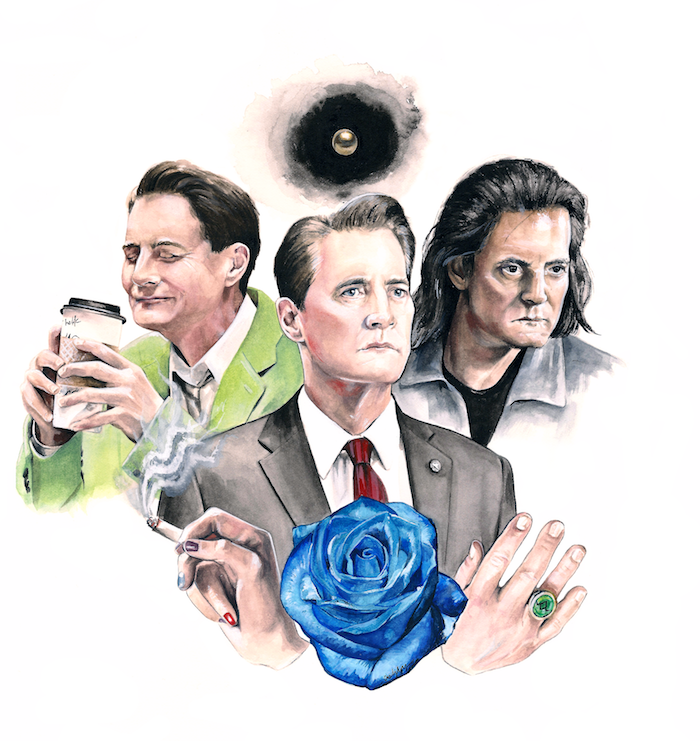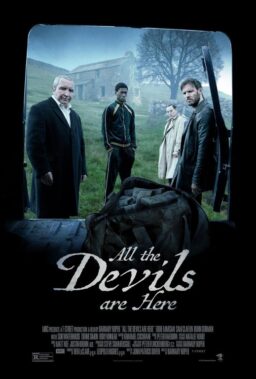We are pleased to offer an excerpt from the latest by online magazine Bright Wall/Dark Room, which now publishes content weekly but with a monthly theme. Their theme for September is David Lynch, whose series “Twin Peaks” is celebrated in the piece below by Kelsey Ford. Bright Wall/Dark Room will be spending all month with Lynch’s films and television shows, including looks at “Blue Velvet,” “Lost Highway,” “Fire Walk With Me,” “The Straight Story,” “Mulholland Drive,” “Dune,” “Inland Empire” and more. They’ve also launched a brand new version of their website, and are offering huge subscription discounts all month long.
You can read previous excerpts from the magazine by clicking here. To subscribe to Bright Wall/Dark Room, or purchase a copy of their current issue, click here.
“Yes, it is a dilemma. Is there an answer? Of course there is: as a wise person said with a smile: ‘The answer is within the question.’”
– The Log Lady, Season 2 Episode 5
What year is this?
Agent Cooper who maybe isn’t purely Agent Cooper stands in the middle of the street, outside the Palmer’s home which is not the Palmer’s home. Two stories. White. House number 708. Laura Palmer is next to him, but she’s not Laura Palmer. She’s Carrie Page, a waitress from Odessa, Texas. She doesn’t recognize the house or the town or any of it.
What year is this?
***
This is the world of Fire Walk With Me by way of Twin Peaks: The Return. Black and white. The night of Laura Palmer’s death. A turning ceiling fan. That two-story white house, a heart-shaped wreath on the front door. House number 708. A throttling motorcycle takes off down the street.
In the penultimate episode of The Return, Agent Dale Cooper (Kyle MacLachlan) is sent back from 2017 (presumably) to February 23, 1989, to prevent an original trauma. He’s wearing his signature black suit. His hair is coiffed. And he’s waiting for the right moment, which isn’t now. For now, he stands back behind a tree, watching Laura Palmer (Sheryl Lee) and James Hurley (James Marshall) as they clutch at each other. Over James’s shoulder, Laura sees Cooper and screams. It’s a scream we recognize from the movie; a familiar moment has been rewired.
Later, after Laura stumbles off James’s motorcycle and back into the forest, Cooper finds her again. She doesn’t know who he is, but then she does. She’s seen him in a dream. He extends his hand; she takes it. He leads her away from the night Laura Palmer died. Leo and Jacques and Ronnette will be kept waiting by the pickup truck. No one will find a body wrapped in plastic along the shore.
As Cooper and Laura walk forward, the world goes from black and white to color. One timeline becomes another.
But then, Laura’s gone. A scream ripples through the forest.
Cooper saved Laura, and then he lost her.
***
In the tenth episode of The Return, two separate characters talk about time. Margaret (Catherine Coulson), the Log Lady, calls Deputy Tommy ‘Hawk’ Hill (Michael Horse) and tells him: “Watch and listen to the dream of time and space. It all comes out now, flowing like a river. That which is and is not.” Then she tells Hawk that Laura is the One.
Earlier in the episode, Deputy Chad Broxford (John Pirruccello) hovers over Lucy Brennan (Kimmy Robertson) at the receptionist’s desk. When he makes an offhand joke about how optimistic Lucy must feel in the morning, she responds with, “That depends on what time it is. I mean, sometimes there’s not even enough time to think of anything. One time, Andy was even thinking that the clock had stopped, and then we realized that we didn’t even know what time it was! It seemed like forever when—”
In a town like Twin Peaks, time can stretch and shrink and morph. When we return to it and its residents in the new series, it’s with a calibration that feels known and uncanny. Few of the residents have stepped outside the bounds they lived within in 1991. Big Ed Hurley (Everett McGill) and Norma Jennings (Peggy Lipton) still look at each other with the pining sweetness of unrequited love, Ed from his Gas Farm and Norma from her booth at the Double R Diner. Andy Brennan (Harry Goaz) still works as a deputy; Lucy Brennan (Kimmy Robertson) still mans the station’s front desk. Hawk answers calls from the Log Lady with a kindness we’ve learned to expect. James Hurley sings at the Roadhouse, his falsetto pointed toward another girl he shouldn’t love. Ben Horne (Richard Beymer) sits behind his desk at The Great Northern, trying to source the low hum that bothers him. His brother, Jerry Horne (David Patrick Kelly), now owns a marijuana shop and spends much of the season lost on a trip, both literal and metaphysical.
Some of the characters’ locked-in routines are more malignant than others. Shelly Johnson (Mädchen Amick), still a waitress at the Double R, works herself up over her daughter Becky’s (Amanda Seyfried) toxic relationship, but when she tries to talk sense into Becky while Becky’s father, Bobby Briggs (Dana Ashbrook) sits next to her in the booth, she forces Bobby to watch her run into the arms of another man who’s wrong for her, this one a drug dealer. There is a routine these characters fall into, when they let a trauma root in their cartilage.
Some characters fight to break out of their long-entrenched rhythms. Ed’s wife, Nadine (Wendy Robie), through the help of Dr. Jacoby’s Gold Shit-Digging Shovels (“Shovel your way out of the shit!”), realizes the hurtful cycle she and Ed have been in all these years. She tells him to go to the diner and love that woman, and he does. After all these years, Ed and Norma find their future together. Bobby now works as a deputy––a redemption for someone whose frequency used to be tuned toward destruction and an inevitability for someone whose father played such a key role as a major in the military.
Some, however, can’t break their loop, as if time for them has become a vicious and malignant continuous moment. Sarah Palmer (Grace Zabriskie), especially, is stuck. Caught in the house that should have been her home, she drinks vodka and chain smokes while a looped wrestling match plays out on her television screen.
It may be 2017, but the trauma of 1989 still lives in Twin Peaks.
***
Agents Dale Cooper, Phillip Jeffries, Chester Desmond, and Major Briggs are still missing. Back in 1989, Jeffries thought he was getting close to figuring out the answer to the root of “the mother of all evils,” but now he “doesn’t really exist anymore.” With Deputy Director Gordon Cole (David Lynch), Cooper had come up with a plan to end it, but Cooper should’ve been back by now.
Which is what Gordon tells Agents Albert Rosenfield (Miguel Ferrer) and Tammy Preston (Chrysta Bell), just before he receives a phone call telling him that Cooper has returned and is headed for the town of Twin Peaks.
This has been a long time coming. In Fire Walk With Me (1992), Lynch’s prequel to the original run of Twin Peaks, Phillip Jeffries (David Bowie) bursts into the FBI office shared by Gordon and Albert. Time glitches. In the hallway, Cooper’s image pauses in the security camera while Jeffries stumbles forward. He’s been gone for nearly two years with no explanation. The gathered group can’t understand what he’s talking about. Albert jokes about a hit to Jeffries’ “noggin.”
This startling, opaque scene is expanded as part of “The Missing Pieces,” 90 minutes of scenes cut from FWWM and then included in Twin Peaks: The Entire Mystery, the 2014 Blu-ray edition of the show’s original run and FWWM. In this version, Jeffries’ sentences seem even more dissociative, but then he settles his cheek onto Gordon’s desk and saying: “February. 1989.”
A month that has yet to pass, but a month that, eventually, Cooper will be sent back to. The month of Laura Palmer’s death.
It hasn’t occurred yet, and already, they’ve begun to circle around it.
***
Trauma’s impact on time can be severe and fracturing: Moments are lost, others are expanded beyond their import. It can feel as if we exist inside of a scene falsely or incongruously. Pieces don’t fit together. There’s always too little and too much of everything. Blink and you’re somewhere else, sometime else.
In The Return, this is all made literal. There are subtle hints that realities have spliced: a credits scene that shows a time-looped Ed in the window of Big Ed’s Gas Farm, and another that cuts quickly from one crowd at the Double R Diner to another, but on the same night. There are glitches and repetitions. Background characters walk forward and then backwards. Characters in the Roadhouse discuss other characters we’ve never heard of.
It’s not until episode 18 that we understand just how severe the separation in these realities have become.
Maybe after, maybe before, maybe simultaneously alongside the moment Cooper saved Laura from her death, Cooper and Diane (Laura Dern) drive through mile 430, as the Fireman had instructed. Electrical wires string through the sky. Oily darkness envelops what once was day.
Things aren’t as they should be. Diane sees herself outside the hotel before they go in. The next morning, Cooper wakes up to a note from Linda to Richard and no Diane in his bed. When he leaves the room, it’s to a different hotel and a different car, both more modern than from the night before. At a diner, Cooper doesn’t drink the coffee poured into his mug, but he does kick a menacing cowboy in the groin and shoot another in the foot, before grabbing their guns and deep-frying them.
This place isn’t home, and Cooper isn’t purely Cooper; as if crossing over into this new place has blended together the disparate pieces of himself that we saw spread out through his original self, his evil doppelganger, Mr. C, and the catatonic decoy created by Mr. C.
Cooper arrives at a house, expecting to find the girl he saved inside. Laura does answer, but she’s not Laura, her name is Carrie Page, and there’s a dead man with his brains splattered across her living room wall.
This world is not the world he expected, but Cooper has a plan.
He’s going to bring Laura home.
***
Before the release of Twin Peaks: The Return but after it finished filming, Mark Frost released The Secret History of Twin Peaks, a novel-as-dossier. The book expands on the series’ already vast mythology and intertextuality: from side trips taken by Lewis, to Aleister Crowley’s writing about two lodges of magicians, to Jack Parsons conducting magic sex rituals to open a portal to hell, to L. Ron Hubbard interviewing Richard Nixon, to Kennedy assassination conspiracies, to the Freemasons, the Illuminati, Native American burial grounds, alien invasions and UFO debunking, Bigfoot sightings, and dealings with the occult.
One section includes pages from a book written by Dr. Jacoby, The Eye of God: Sacred Psychology in the Aboriginal Mind. After consuming ayahuasca, he has a vision:
When I opened my eyes, two things occurred: I realized that I was no longer where I thought I had been, and at the same moment no longer know who “I” was… at some level I registered that what I was seeing was not what was physically in front of me. I also knew that the veil of “reality” has been rent, split or torn away and that I was looking into a different or perhaps deeper dimension, one that either underlies ours or that coexists with it side by side, separated by the thinnest margin imaginable.
As if the flimsiest of membranes separates one reality from another.
The implications of this book are vast. There are answers that only exist inside of it, but also suggestions of traumas in other places that can be traced back to the same root, even if they’re not contained within this particular story about a dead girl and her detective. The portals we see on screen––in Glastonbury Grove, in Buenos Aires, in New York City––suggest that there are more out there than we know. More BOBs. More Laura Palmers. Maybe, even, more Agent Coopers. By opening up the universe of Twin Peaks, The Secret History of Twin Peaks suggests ever-expanding ripples and repetitions, the inevitability of this particular battle.
***
It was always going to come down to Agent Dale Cooper and Laura Palmer; the dead girl and her detective. But on the other side, in this world where Linda abandons Richard and Laura Palmer never dies, they’re shades of themselves. Laura is Carrie is alive. Cooper is Richard is not pure good nor pure evil.
Maybe Cooper finds himself in a different dimension or a different timeline in the same dimension. Or perhaps he’s stuck in a time loop––always trying to save Laura Palmer, always succeeding, always finding himself back in the Black Lodge, before being sent out and into Dougie’s body. Perhaps crossing over at the 430 mile mark was the only way to collapse these two worlds and escape the Cooper-created loop.
Was this his plan? To reach this moment in time, when Laura Palmer never died, but also, perhaps, never existed either?
As a season, Twin Peaks: The Return contains itself. It answers its own questions and then undoes its entirety. It loops back, interrupting its own story, unsettling pieces it had already placed. Either Cooper and Laura are headed home or they’ll never go home again. Maybe both are true. Maybe neither are.
This world has already gone through so many traumas. This is one it might not survive.
***
Cooper walks Laura up to her front door and knocks, but Sarah Palmer doesn’t answer. The woman who does live there doesn’t know who the Palmers are, didn’t buy the house from the Palmers, doesn’t recognize Laura, doesn’t know what these two strangers are doing on her doorstep or what they could possibly want.
It didn’t work.
Cooper and Laura walk back out to the street. Dazed by the drive and the failure, not sure what to do next. Cooper begins to rock backwards and forwards, asking: “What year is this?”
Not: What year is it? But: What year is this?
The question suggests a temporal looseness, a sense that Cooper has been here before, but now it’s lacking landmarks, a known solidity. He’s been so dead-set on saving Laura Palmer, but what has saving her done? Indeed: what has it undone?
The past dictates the future, but what happens when that past isn’t the past it once was?
Have we been here before?
An echo of a mother, yelling for her child. And then a scream. Perhaps, a recognition. A shattering, a collapse, a folding.
What year is this?











